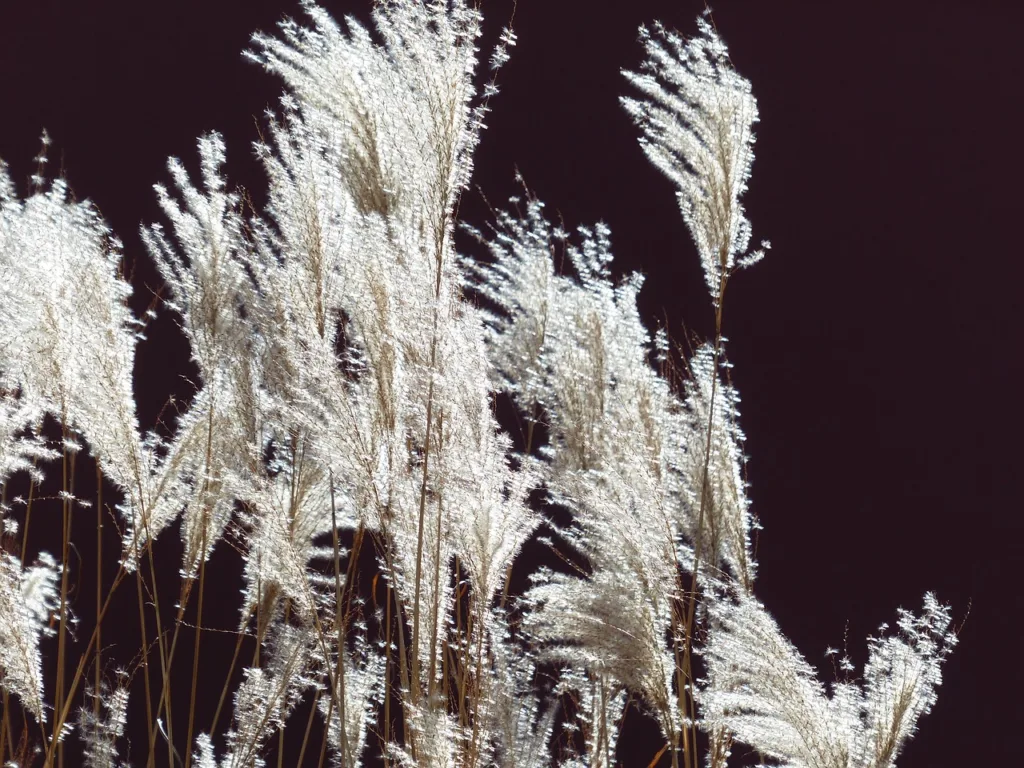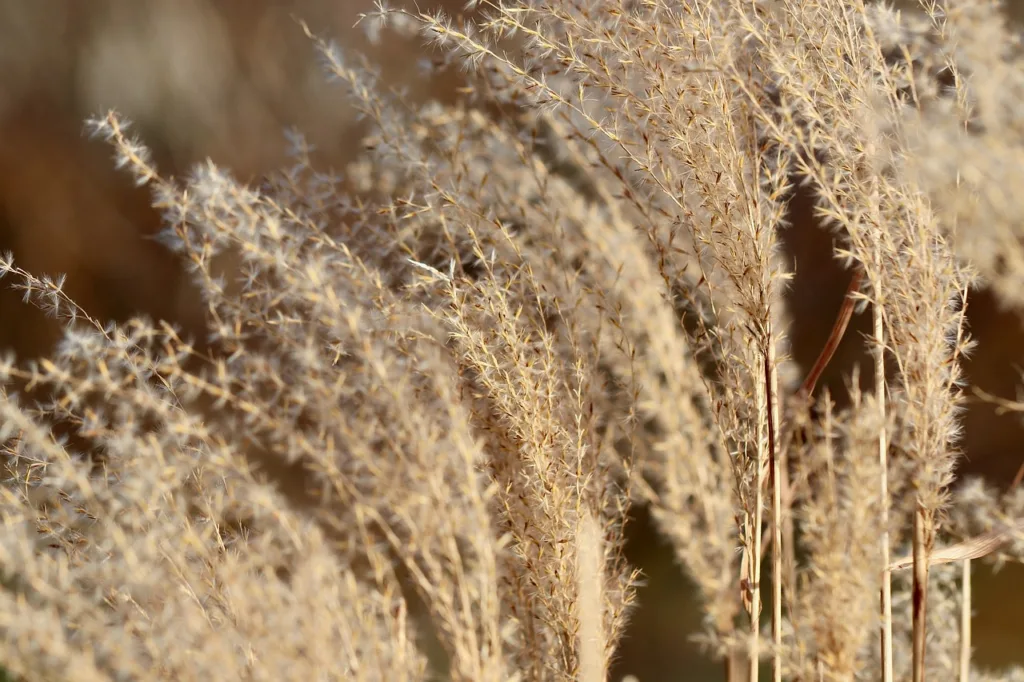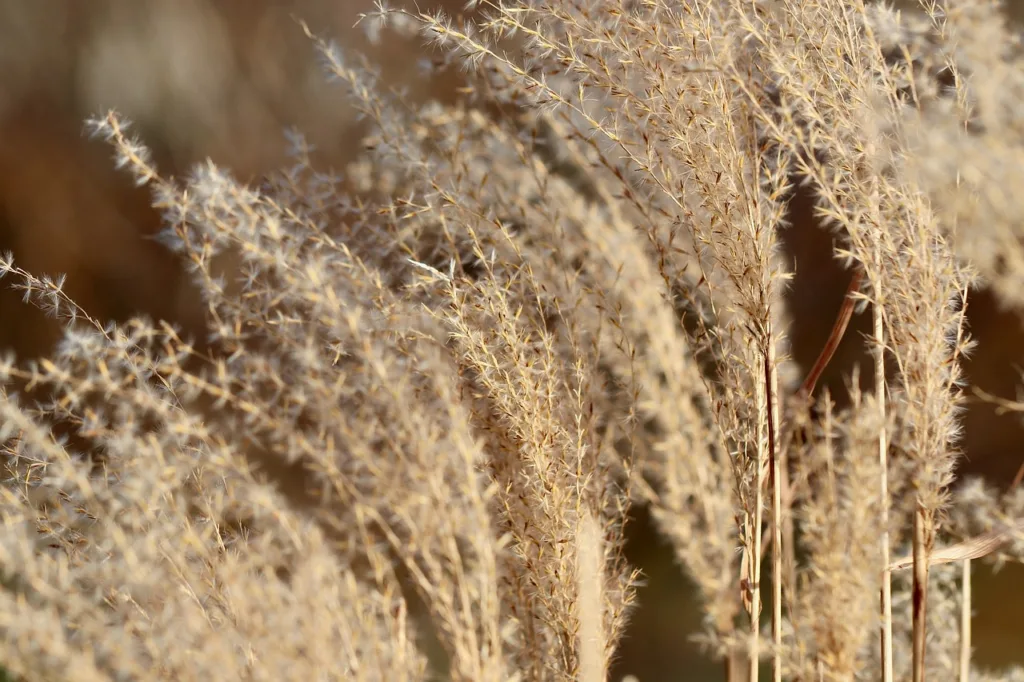Chinese Silver Grass, scientifically known as Miscanthus sinensis, is a popular ornamental grass that adds beauty and texture to any garden.
Chinese Silver Grass is a perennial grass. It is born in East Asia, especially China, Japan, and Korea. It belongs to the Poaceae family and is known for its upright growth habit and clumping nature.
The grass can reach heights of up to 8 feet, making it an excellent choice for creating dramatic focal points in your garden.
Chinese silver grass is an all-round plant that can be grown in a variety of landscapes and gardens. With its graceful arching stems and feathery plumes, it is a wonderful addition to any garden.
| Characteristic | Description |
|---|---|
| Scientific Name | Miscanthus sinensis |
| Common Names | Chinese Silver Grass, Maiden Grass |
| Family | Poaceae (Grass family) |
| Origin | East Asia (China, Japan, Korea) |
| Appearance | Tall, slender stems with arching foliage |
| Leaf Color | Green or variegated |
| Flower Plumes | Feathery plumes in late summer to fall, ranging in color from silver to pink or red |
| Height | Varies, typically 3 to 15 feet or more |
| Adaptability | Adaptable to various soil types and climates |
| Landscaping Uses | Focal point, border or hedge, mass plantings |
| Cultural Significance | Some cultural significance in East Asia |
| Wildlife Attraction | Provides habitat and food for wildlife |
| Invasiveness | The potential to naturalize and spread may be considered invasive in some regions |
| Erosion Control | Used in erosion control efforts due to its extensive root system |
The Right Location of Chinese Silver Grass
When growing Chinese Silver Grass, selecting the ideal location is crucial for its long-term success. Here are some factors to consider:
Sunlight
Chinese Silver Grass thrives in full sunlight, so choose a location that receives at least 6 to 8 hours of direct sunlight each day.
Soil
This grass prefers well-draining soil with a pH range of 5.5 to 7.5. Before planting, amend the soil with organic matter such as compost to improve its fertility and drainage.
Space
Chinese Silver Grass requires ample space to spread out and grow. Make sure to plant it in an area where it won’t overcrowd other plants or structures.
Planting Chinese Silver Grass
Now that you’ve found the perfect location, it’s time to plant your Chinese Silver Grass. Here’s a step-by-step guide to help you get started:
Prepare the soil
Dig a hole that is twice as wide and deep as the root ball of the grass. Loosen the soil at the bottom of the hole to encourage root growth.
Place the plant
Care remove the grass from its container, and gently tease the roots apart to promote growth. Place the plant in the center of the hole.
Fill the hole
Fill the hole with soil, ensuring that the grass is planted at the same level as it was in the container. Press the soil gently around the plant to eliminate air pockets.
Water thoroughly
After planting, water the grass thoroughly to help settle the soil and remove any remaining air pockets. Continue to water regularly, especially during the first growing season.
Watering and Fertilizing Chinese Silver Grass
Watering and fertilizing are essential aspects of Chinese Silver Grass care. Here’s what you need to know:
Watering
Chinese Silver Grass is drought-tolerant once established, but it requires regular watering during its initial growth period.
Water deeply but infrequently to encourage the roots to grow deeply. Avoid overwatering, as it can lead to root rot.
Fertilizing
Chinese Silver Grass benefits from a balanced slow-release fertilizer applied in spring. Follow the manufacturer’s instructions for proper application rates. Avoid overfertilizing, as it can cause the grass to become overly lush and prone to flopping.

Pruning and Maintenance of Chinese Silver Grass
Proper pruning and maintenance are essential for the health and appearance of Chinese Silver Grass. Follow these guidelines to keep your grass looking its best:
Pruning: In early spring, before new growth appears, cut back the giant grass to a height of 4 to 6 inches. This encourages vigorous growth and prevents the grass from becoming too leggy. Additionally, remove any dead or damaged foliage throughout the growing season.
Dividing: Chinese Silver Grass can become crowded over time. To maintain its vigor, divide the clumps every three to four years. Dig up the entire clump and carefully divide it into smaller sections. Replant the divisions, and water thoroughly.
Weeding: Regularly remove any weeds or grasses that may encroach upon your Chinese Silver Grass. Weeds can compete for nutrients and water, hindering the growth of your ornamental grass.
Overwintering Chinese Silver Grass
Chinese Silver Grass is typically hardy in USDA zones 5 to 9, but in colder regions, it may require extra protection during the winter months. Here’s how to help your grass survive the winter:
Cutting back: Once the grass has turned brown in late fall or early winter, cut it back to a height of 4 to 6 inches. This reduces the risk of snow and ice damage.
Mulching: Apply a layer of mulch around the base of the grass to insulate the roots and protect them from freezing temperatures. Use organic materials such as straw, shredded leaves, or wood chips.
Types of Chinese Silver Grass
Here are some popular types of Chinese Silver Grass:
‘Morning Light’ (Miscanthus sinensis ‘Morning Light’)
Characteristics: This cultivar is known for its fine, narrow leaves with silver-white midribs. It has a graceful, arching habit and is prized for its elegant appearance.
‘Gracillimus’ (Miscanthus sinensis ‘Gracillimus’)
Characteristics: With narrow green leaves and a more upright growth habit, ‘Gracillimus’ is one of the most popular cultivars. It forms large clumps and produces feathery, reddish-brown plumes in late summer.
‘Zebrinus’ (Miscanthus sinensis ‘Zebrinus’)
Characteristics: This cultivar is known for its distinctive horizontal golden stripes on its leaves, resembling a zebra pattern. The arching foliage adds a dynamic element to the landscape.
‘Little Kitten’ (Miscanthus sinensis ‘Little Kitten’)
Characteristics: As a dwarf variety, ‘Little Kitten’ is more compact and suitable for smaller gardens. It retains the attractive arching habit and feathery plumes characteristic of Chinese Silver Grass.
‘Adagio’ (Miscanthus sinensis ‘Adagio’)
Characteristics: ‘Adagio’ is a smaller cultivar that forms neat, dense clumps. It features narrow green leaves and produces delicate, silvery plumes in late summer.
‘Variegatus’ (Miscanthus sinensis ‘Variegatus’)
Characteristics: This cultivar stands out for its variegated leaves, featuring cream-colored stripes. It adds a bright and dynamic element to garden borders.
‘Silberfeder’ (Miscanthus sinensis ‘Silberfeder’)
Characteristics: With a more upright and columnar growth habit, ‘Silberfeder’ produces large, silvery-white plumes in late summer and fall. It creates a bold and striking focal point in the landscape.
‘Cosmopolitan’ (Miscanthus sinensis ‘Cosmopolitan’)
Characteristics: This cultivar offers variegated leaves with green and white stripes. It has a compact and upright form, making it suitable for various garden settings.
Chinese Silver Grass for Sale
Local Nurseries and Garden Centers:
Visit nearby nurseries or garden centers. They often carry a variety of ornamental grasses, including different cultivars of Chinese Silver Grass. Nursery staff can guide the best choices for your specific garden conditions.
Online Plant Retailers:
Explore online plant retailers that specialize in ornamental grasses. Many websites offer a wide selection of Chinese Silver Grass varieties, allowing you to browse and choose based on your preferences. Make sure to check reviews and ratings for the seller’s reputation.
Garden Shows and Plant Sales:
Attend local garden shows, plant sales, or gardening events. These gatherings often feature multiple vendors, including specialty nurseries that may have a diverse collection of Chinese Silver Grass for sale.
Landscaping Companies:
Contact local landscaping companies that offer plant installations. Some may sell plants directly to homeowners, and they might have Chinese Silver Grass available or be able to source it for you.
Online Marketplaces:
Explore online marketplaces like eBay, Etsy, or specialized plant marketplaces. Some individual sellers or nurseries use these platforms to offer a variety of plants, including Chinese Silver Grass.
Botanical Gardens or Arboretums:
Check with local botanical gardens or arboretums. Some have plant sales or partnerships with nurseries, providing an opportunity for you to purchase Chinese Silver Grass directly from these institutions.
Local Plant Exchanges:
Participate in local plant exchanges or gardening clubs. Fellow gardeners may have divisions or surplus Chinese Silver Grass plants that they are willing to share or sell.
| Before planting Chinese Silver Grass, it is advisable to check with local agricultural extension offices, conservation authorities, or environmental organizations to determine whether it is classified as invasive in your region. If it is considered invasive, alternative native or non-invasive ornamental grasses may be recommended for landscaping to avoid potential ecological impacts. Always be responsible in the cultivation of plants and follow local guidelines to protect the environment. |

Conclusion
Growing and caring for Chinese Silver Grass can be a rewarding experience. With its elegant appearance and low-maintenance nature, this ornamental grass is a fantastic addition to any garden.
By selecting the right location, providing adequate watering and fertilizing, and performing regular pruning and maintenance, you can enjoy the beauty and resilience of Chinese Silver Grass for many years to come.
So why not create a captivating landscape while embracing the tranquility and grace of this stunning grass? Start growing and caring for Chinese Silver Grass today!
People also ask
What is Chinese Silver Grass used for?
Chinese Silver Grass (Miscanthus sinensis) is commonly used in landscaping for its ornamental appeal.
It serves as a focal point in gardens, adds texture to landscapes, and is used for borders, hedges, or as mass plantings. Some varieties are also used for erosion control.
How is Chinese Silver Grass invasive?
Chinese Silver Grass can be considered invasive in certain regions due to its ability to naturalize and spread quickly.
The plant produces viable seeds, and its extensive root system allows it to colonize areas rapidly, outcompeting native vegetation.
What kills Chinese Silver Grass?
Controlling or killing Chinese Silver Grass can be challenging due to its resilience. Effective methods include physical removal by digging up the plants, cutting them down, or using herbicides containing glyphosate.
However, caution is needed when using herbicides to prevent harm to surrounding vegetation.
What is the common name for silver grass?
“Silver Grass” is a common name for various ornamental grasses, but it is often associated with Miscanthus sinensis, particularly the cultivars known for their silver or silvery plumes.

